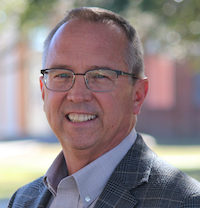Richard Elligson
Richard Elligson earned a PhD in Theology from Mid-America Baptist Theological Seminary. Archives

Richard Elligson earned a PhD in Theology from Mid-America Baptist Theological Seminary. Archives
Session 2
April 21, 2024
SHARING CHRIST
Matthew 28:18-20; 2 Corinthians 5:16-21
Christ’s ascension marked the end of His earthly ministry. He is now seated at the right hand of the Father, awaiting the day of His return for the church. In the meantime, His church is charged with its own ministry: making disciples. Unlike some of the more difficult teachings of the Scriptures, the Great Commission is quite easy to understand. Jesus made it crystal clear what needed to be done and how to go about it.
The Great Commission method (Matt. 28:18-20). The Great Commission (in one form or other) is recorded in all four Gospels and again in Acts. As the final words of Jesus, the command carries tremendous weight. When Jesus said, “It is finished,” His work was done, but the church’s work was just beginning. Several key principles are expressed. The first and last phrases act as “bookends” to the commission. Verse 18 mentions His power. “All authority has been given to Me in heaven and on earth.” In this case, “All authority” means just that! Verse 20 mentions His presence. The promise “I am with you always” was a clear encouragement to His disciples then, just as it is to us today. Sandwiched between those two promises are four components of the Commission itself. First, believers are told to “Go.” Scholars have argued through the centuries whether this is an imperative (GO!) or a simple participle (“As you are going…”). Both translations are acceptable, and both are appropriate! Yes, “go!” and yes, “as you go!” Sharing the good news of Christ should be both intentional and incidental. Second, “make disciples of all nations;” not simply interested parties (as the multitudes often were), but true and dedicated followers of Christ. And not just nearby, but to the ends of the earth (see also Acts 1:8). Third, “baptizing them…” (literally, “immersing them.”). This is not a means of salvation, nor is the so-called “baptismal formula” a verbatim requirement for true baptism. But baptism was (and is) an important public proclamation of one’s commitment to Christ. In fact, in the New Testament (and in many parts of the world today), baptism acted as the profession of faith. Fourth, “teaching them to observe everything I have commanded you.” Notice especially the order: make Christ-followers, then baptize them, then teach them. For reflection: Given the clarity of the teaching, why have so many churches strayed from its simplicity, separating the profession of faith from baptism, and/or requiring doctrinal classes before agreeing to baptize?
The Great Commission message (2 Corinthians 5:16-21). Once the apostle Paul was knocked off his donkey in Acts 9, he took the Great Commission very seriously! His life was dedicated to spreading the Gospel, and his writings were dedicated to defining it and defending it. In some places (like 1 Cor. 15:1-4), his explanations are general and somewhat generic. But in others, his teachings expound on the finer points of the Gospel. This text is an example of that. The key component in this text is the doctrine of reconciliation. “Forgiveness” is one thing. It deals with the “legal debt of sin.” In other words, through Christ’s sacrificial death and our acts of repentance and faith, Christ justifies us, declaring us “not guilty.” As verse 19 says, God no longer counts our trespasses against us. That is forgiveness, and that is a wonderful thing! But there is more. Not only is the debt of sin we owed removed (not counted against us) but God makes a deposit of Christ’s righteousness into our account (v. 21). But there’s still more! Whereas forgiveness removes our debt of sin, reconciliation restores our relationship with God. We who were once “far away” from God, have been brought back close to Him (see Eph. 2:13). In other words, the ideal and original relationship for which we were created (and which sin has destroyed), has been restored by Christ. For this reason, we are new creations in Him (v. 17). So, what is the message of the Great Commission? That sinners who were once helplessly and hopelessly lost, can now be brought back into a right relationship with our creator, through Christ’s sacrificial death. That was His service to us…and now is our service to others (v. 19). For reflection: Reread verses 18 and 19. Who is doing the reconciling here? What does this tell us about the sovereignty of God? What does it say about His character?
Session 1
April 14, 2024
BUILT ON CHRIST
1 Peter 2:1-12
My first paying job was picking up little red wagon loads of stones from the yard and dumping them in the driveway. My dad paid us 10 cents a wagon load. I learned that they were sharp, dirty, and heavy; fun to throw at things, but not much fun to pick up. Yet stones are useful. Roads (and driveways like mine) are paved with them. Buildings are made with them. Some are craggy and some are smooth. Some are impervious and some are porous; some are precious, and some are worthless. Some are ugly, yet others can be carved into beautiful sculptures or formed into kitchen countertops.
This week’s lesson is all about stones. Peter knew something about stones, since Jesus called him one in Matthew 16:18. Here, the apostle used the name Jesus gave him to teach us about Christ and His church. Three specific “stones” are mentioned.
Living stones (vv. 1-5). After the apostle pointed out the human side of church life, which is distinct from secular life, being nurtured and matured by the word of God, he mentions the more structural aspect of the church. Indeed, believers are babes in need of nurturing (v. 2), but they are also stones (vv. 4 and 5). The contrast is severe! One is the most vulnerable part of nature. The other is the most enduring. I was always amused by a video clip of “Earth First” hippies mourning the loss of old-growth trees in the mountains of North Carolina. One young lady pointed out a rock that “has the most incredible life.” Such a claim is so ridiculous as to be laughable. Rocks and stones are inorganic; incapable of having life. Yet that’s what Peter calls Christ-followers. And that’s the point! Peter attributes the qualities of natural stones to believers when he calls us living stones. Christ is our example. He was cast aside as ordinary by the people of His day (see John 1:11) but He was “chosen and valuable” from God’s point of view. And just as stones were used to build the physical temple, living stones are used to build the “spiritual” temple. What God wanted for Himself was not a physical temple to host ritual ceremonies that could not take away sin (see Heb. 10:4), but a spiritual temple; a congregation of priests offering living sacrifices. For reflection: Read Romans 12:1-2. How do you think “living sacrifice” fits into the discussion of “living stones?”
Corner stone (vv. 6-7). Here, Peter refers back to Christ. The quote is found in Isaiah 28:16 where it brought hope of the coming Messiah. Jesus of course, fulfilled that prophecy. Three important features are notable. First, Christ is the chief cornerstone (v. 6). Architecturally, the cornerstone was a carefully cut stone laid flat and square. That stone then became the reference point for the rest of the structure; the point from which all measurements were made, and all angles squared. Ceremonially, the cornerstone was often set with solemn celebration. It symbolized the beginning of something new. Second, that cornerstone (Christ), was originally rejected by His own people. Third, those who trust in Him (as builders would trust the integrity of the cornerstone) will never be ashamed (see also Rom. 10:11). For reflection: The word “ashamed” is also translated “disappointed.” Which word seems to fit the context better? Why?
Stumbling stone (vv. 8-12). Christ always divides. In Luke 12:51 ff, He said He would divide households and families. In our Easter lesson, His cross stood between the believer and the unbeliever. Here, Peter used the metaphor of the stone to illustrate another division: Christ the rock will either set you straight (as a cornerstone), or trip you up (as a stumbling block). Verse 9 distinguishes those who are set straight from those who fall. “But you…” is in contrast to those who disobey in verse 8. I always warned my students to be cautious in applying Old Testament promises made to Israel to the church (simply put, Israel is not the church!). But here it is okay to do so, since Peter does it, by claiming the promise made to Israel in Exodus 19 and applying it directly to the church. The promise is clear: God has chosen the church to be His people (v. 10). For reflection: Read verses 11 and 12. How is the church’s behavior supposed to distinguish it as God’s chosen people?
Session 6
April 7, 2024
THE MISSION OF JESUS SHARED
Luke 24:44-53
With the end of redemptive history completed on earth, Jesus ascended to His rightful (and original) place at the right hand of the Father. The Bible pictures Him “seated” there in fulfillment of the Scriptures. It is a place of rest from His redemptive work and a place of reigning over His redeemed kingdom. But He won’t stay seated there forever…for His second coming is as certain as His first! And while His redemptive work on earth is done, ours is not. The Great Commission is exactly that. With eternity in the balance, taking the gospel of salvation to the world is both the greatest of all challenges and the most meaningful of all activities. It is also a sacred duty. In Luke’s account, these last words of the Lord are neatly divided into four W’s.
Words (vv. 44-45). Here at the end of His earthly ministry, Jesus’ words are particularly packed with meaning. Each detail is included for a reason. Verse 44 reveals the origin of Jesus’ teaching. They are His words, proclaimed over the 3 years that Jesus was with them. But more than that, they were His words prophesied throughout the entirety of Scripture. The Law, the Prophets, and the Psalms (or “Writings”) represent the three classical divisions of the Hebrew Old Testament. By fulfilling them all, Jesus was once again declaring that His redemptive work on earth was done (see Matt. 5:17). Verse 45 is interesting. Just as Jesus opened their eyes to recognize Him (see John 20:11ff; Luke 24:31), He opened their minds to understand the Scriptures, specifically as they related to His fulfillment of the messianic prophecies. For reflection: We tend to think of understanding the Scriptures as a spiritual discipline. What does verse 45 say about the role of our minds as well?
Written (vv. 46-47). “He also said to them…” indicates a change in context. Whereas He had already fulfilled the messianic texts, here He emphasized His messianic task. The simple gospel recorded in the Bible consists of the good news of Christ’s sacrificial death, which included both the payment for sin and the satisfaction of God’s judgment (hence He “would suffer”) according to the Scriptures; His burial; and His resurrection on the third day, according to the Scriptures (see 1 Cor 15:3-4). That’s the message in verse 46. Verse 47, then, gives the mandate: repentance was the requirement for forgiveness of sin. Earlier, Jesus had proclaimed, “Unless you repent, you will all perish” (Luke 13:3). The method for spreading this good news? Proclamation! Paul stated it clearly: “Faith comes by hearing, and hearing by the word of God” (Rom. 10:17). Finally, the intended audience for the good news is “all nations,” starting exactly where they were…. Jerusalem. For reflection: I know there are dozens of ways to share the gospel (and I have tried them all!). But no better way exists than to sit down one-on-one with a person and share the gospel directly from the Bible. Are you ready, willing, and able to do just that?
Witness (v. 48). The term “witness” is usually used in a legal context. Simply put, a witness is someone who can testify directly and personally to what he or she has seen, heard, or experienced. Jesus’ pointed out that the only ones capable and credible when it comes to sharing the gospel, are those who have personally experienced the salvation that Jesus gives. The good news about that is that no special training or special gifts are necessary to share about Christ. One only needs a legitimate salvation experience with Him. The challenging news is that we are ALL “witnesses of these things.” Hence, we are ALL as responsible to share the gospel as the original disciples! For reflection: If we are saved and we are responsible for sharing Christ with “the nations,” why do you think so few people actually do it?
Worship (vv. 49-53). With the promise of the Holy Spirit’s empowerment (see Acts 1:8), the witnesses were blessed by Christ personally, who then ascended personally into heaven. What followed would set the stage for the early church’ major activity: worship. Notice that they were filled with worship, joy, and continual praise. But notice as well where they were gathered: in God’s house. This meant that gathering together corporately for worship was an integral part of the early church’s life. For reflection: Read Heb. 10: 25. How does that verse inform our study? What does it say about believers’ failure to gather?
Session 5
March 31, 2024
THE RESURRECTION OF JESUS
Luke 24:1-8; 38-43
Hebrews 11:1 teaches us that “faith is the substance of things hoped for and the evidence of things not seen.” But that doesn’t mean that faith is some kind of blind leap in the dark! Rather, our faith is based on evidence. As a historian, Luke was mindful of recording the facts surrounding Jesus’ life and His death. And He was equally dedicated to recording the facts about the resurrection. In fact (no pun intended!), Christ’s death, burial, and resurrection are so central to the gospel of salvation (see 1 Cor. 15:3-4) that nothing short of certainty will do. In this week’s lesson, three evidences of the resurrection are mentioned, all of which point to the fact that Jesus rose again.
The testimony of Jesus’ absence (vv. 1-6). Luke’s account of Resurrection Morning focuses on the actions of the dedicated women who followed the Lord. First, they “came” and they “brought” (v. 1). The remaining details explain the context. It was the first day of the week (Sunday), and it was sufficiently early that it was still dark (John 20:1). After the burial tradition of the Jews, spices had been brought that were prepared prior to the sabbath (Luke 23:56). While a large quantity had been applied by Nicodemus at the garden tomb (see John 19:39), this did not preclude the ladies from following through with their own act of devotion. Next, they “found” and they “didn’t find” (vv. 2-3). What they found was the stone rolled away from the tomb. What they did not find was a body inside! Third, the women “bowed down;” not at the sight of the Lord, but at the sight and subsequent terror of seeing His messengers waiting in dazzling white (v. 5). Notice that all of the evidence presented by the ladies’ actions indicate that Christ really had died, that He really was buried, and that He really was no longer dead in the grave. Then, these facts were confirmed by the angels’ frank proclamation, “He is not here, but is risen!” For reflection: Read 1 Cor. 15:3-4. We all know how important Christ’s death is in God’s redemptive plan. But why do you think His burial and resurrection are also essential elements of the gospel?
The testimony of Jesus’ promise (vv. 6-8). There have always been those who believe that Jesus was somehow caught by surprise by all this and that His death was a tragic result, as if God’s plans had somehow been thwarted. Such thinking is not only erroneous, but it is offensive! It makes God the Father less than sovereign and makes Jesus the Son less than truthful. Over and over, the Lord Jesus warned His disciples of the events that would take place and stated the necessity of fulfilling them. For example, in Mark 8:31, He laid it all out: His suffering, death, and resurrection. He said the same thing again in Mark 9:31 and added even more details in Mark 10:33. As to His own willful intent, the Lord was clear: “No one takes my life from me, but I lay it down” (John 10:18). While the Bible makes it clear that the disciples didn’t fully understand all that would take place or even want to discuss it (e.g. Mark 9:32), this passage in Luke confirms the facts that Jesus had indeed made those predictions and that they indeed remembered them. For reflection: Mark 9:32 says the disciples “did not understand this statement, and they were afraid to ask Him.” Why do you think they were afraid to ask Him? What applications might we make from their reaction?
The testimony of Jesus’ presence (vv. 38-43). While Jesus’ absence from the tomb was one evidence of His resurrection, it was not enough to convince His disciples that He was alive. For this, He needed to appear in person. Notice that that while poor Thomas will always take the blame for it (John 20:24-25), all of the disciples were equally doubtful (see also Mark 16:11). Notice as well that Jesus, after questioning their faith (v. 38), was quick to give evidence to help them believe (v. 39). The wounds from the crucifixion proved that it was Jesus, and the eating of fish proved He was there in bodily form, and not some kind of spirit as they supposed in verse 37. For reflection: Look up Matthew 28:16-17. How do you account for their continued doubts? What applications can we make from these two verses?

Margaret Colson began serving as consulting communications editor for the Florida Baptist Convention in April 2022, but she has a long history of working with Florida Baptists in telling the story of how God is at work in the Sunshine State.
Margaret earned a Bachelor of Arts in journalism from the University of Georgia and a Master of Divinity and Doctor of Ministry from New Orleans Baptist Theological Seminary. She is a leader in denominational communications, serving as executive director for Baptist Communicators Association as well as for Association of State Baptist Publications. She is married to Keith Colson.

Keila earned a B.S. in Communications from Florida International University in Miami. She writes news and stories about Florida Baptist churches, creates and posts social content to the FBC’s social media channels, and is a Baptist Press contributor.
When she’s not working, Keila enjoys bike rides and spending time with her family.

Brooke Mannion is a Pensacola native and longtime member of Hillcrest Baptist Church. She is a graduate of University of West Florida and has a diverse work history in advertising, interior decorating and accounting. Now she finds joy as a wife and stay-at-home mom of three children. Brooke enjoys home schooling, cooking, connecting with others and studying God’s Word.

David Moore has been writing and editing for newspapers and magazines in Florida for more than 20 years. He has a bachelor’s degree in journalism from the University of Florida. A proud member of First Baptist Church of Ocala, David serves in the worship, deacon and NextGen ministries. He and his wife Beth have three children.

Jessica received her B.S. in Biblical Studies from Southwestern Baptist Theological Seminary. She contributes to Florida Baptist Conv, Biblical Woman, Baptist Press, The Devotional for Women, and Daily Devotional Bible for Women. Her greatest joy is serving beside her husband who is the Senior Pastor of Fellowship Church.
